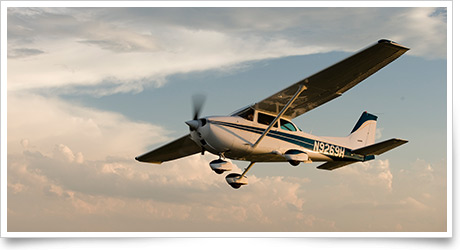Custom content for the Sept. 14, 2012, issue of 'AOPA ePilot' newsletter
| The following stories from the Sept. 14, 2012, edition of AOPA ePilot were provided to AOPA members who expressed an interest in the particular subject areas. Any AOPA member can receive information tailored to their areas of interest by updating their preferences online |
training tipsWily ways of wind
But now it’s getting bumpy up there. The late summer thermal currents have begun their choppy chore a little later in the morning than they did a few weeks ago, but once they get going, they still make an airplane with a typical trainer’s low wing loading bounce about. It’s rough enough for you to think about changing cruise altitudes—but the first step you take is to slow below your trainer’s maneuvering speed. In an airplane such as a lightly loaded 1986 Cessna 172, that can mean reducing airspeed by 15 knots or more.
Slowing down helps, but as you await the appearance of your next checkpoint (a lake), it does not seem to be coming into view on schedule at your revised estimated groundspeed.
OK, there it is—but a bit to the left of its expected position off the nose.
That’s when it occurs to you: Along with the airspeed reduction you made to fight the turbulence, it was necessary to note the new wind correction angle for maintaining course.
You were already holding a significant wind correction angle, so reducing airspeed without adjusting the WCA resulted in gradual downwind drift. (Failing to make that adjustment is also a common cause of aircraft drifting out of position after reducing power and airspeed on the downwind leg of the airport traffic pattern.)
To see an illustration of the effect, get hold of an old-fashioned, non-electrical E6B flight computer, flip it over to the side that solves for groundspeed, WCA, and headings, and work a problem down to Step 6. Use normal cruise power settings to determine true airspeed, and use winds aloft that provide a healthy difference between true course and wind direction. Note the WCA.
Next, work the same problem again with speed reduced to the approximate V A. How much did WCA change?
You made a good decision to slow down for safe operations in the turbulence. Then remember to allow for the effects of that speed change on other aspects of your plan of navigation. While you’re at it, give flight service a pilot report to let other pilots know about the winds aloft. Don’t remember how to do that? The Air Safety Institute’s online course will show you how. training productsSporty’s electronic E6BSporty’s has introduced a revamped version of its best-selling electronic E6B. The unit now comes with a new cloud base function, a larger keypad, and a backlit screen for night operations. And, lest you think your smartphone provides all the functions you need from an E6B, Sporty’s reminds you that you can’t take a smart device into an FAA testing center for knowledge test purposes. The unit sells for $59.95 and can be ordered online or by calling 800/776-7897.
Note: Products listed have not been evaluated by ePilot editors unless otherwise noted. AOPA assumes no responsibility for products or services listed or for claims or actions by manufacturers or vendors. final examQuestion: I’m aware that we as pilots have to carry a photo ID along with our pilot certificates. Is it true that the FAA is the only agency we have to show our certificate and photo ID to if we are asked?
Answer: No. FAR 61.3 (L)(1-4) states that “each person holding an airman certificate, medical certificate, authorization, or license required by this part must present it upon a request from, The (FAA) Administrator, an authorized representative of the National Transportation Safety Board (NTSB), any Federal, State, or local law enforcement officer, or an authorized representative from the Transportation Security Administration (TSA).” See “Legal Briefing: FAA inspector’s authority” for more on this subject.
Got a question for our technical services staff? Email [email protected] or call the Pilot Information Center, 800/872-2672. Don’t forget the online archive of “Final Exam” questions and answers, searchable by keyword or topic. |
 It’s a good feeling to take off and establish your trainer on course for a cross-country flight, a condition confirmed by your checkpoints showing up at the right time, and in the right portion of the windscreen.
It’s a good feeling to take off and establish your trainer on course for a cross-country flight, a condition confirmed by your checkpoints showing up at the right time, and in the right portion of the windscreen.

